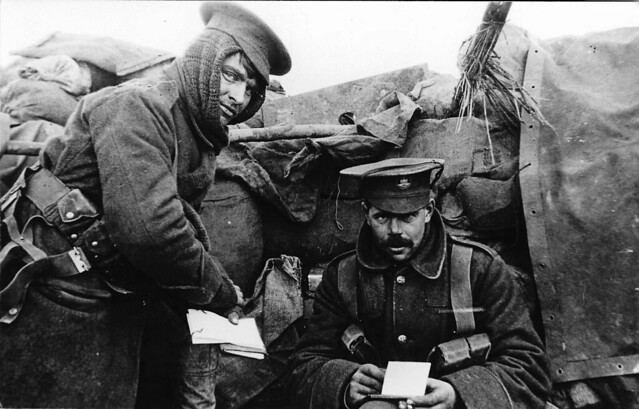25th December 1914
Merry Christmas everyone. I am writing this from my leather wing-backed armchair, fire crackling in the grate, chestnuts roasting (must move back a bit) and dogs at my feet. A glass of Lisbon’s finest at my side is pepped up with some meths from the garage, while Val Doonican croons festively from the gramophone. Are you sitting comfortably? Then I shall begin…
Christmas day 1914 in Wulverghem began with a sharp frost and most of the day was foggy. The Dorsets’ war diary reads as follows:
Quiet Day
Nothing to report
Casualties Nil
Good eh? Now, as everyone is probably bored to the back teeth by already, there were unofficial truces up and down the line on Christmas Day 1914. There are countless reasons why it happened and I won’t go into those here. This book, The Truce, by Chris Baker looks very interesting if you want to read further – although I’ll admit that I haven’t had time either so you’re forgiven too.
The 5th Division’s war diary records the following information:
In afternoon opposite Sector B a large number of Germans and our men meet half way between the trenches and fraternize (sic). Badges show the Germans to belong to Schulenberg’s Landwehr Brigade.
The Bedfords, who now shared Sector B with the Dorsets, also record nothing much in their war diary.
Christmas cards from Their Majesties the King & Queen distributed to all ranks of the Battn. Also present from Her R. Highness Princess Mary. Cold & frosty day. Quiet day. Germans semaphored over that they were not going to fire. Hard frost all day.
However, the Bedfords website annotates this with “[note that a private diary by a battalion member records fraternisation between men of B Company and the Germans in No Man’s Land]” but it doesn’t provide any information about how to find this diary. I thought I would be able to post excerpt here but only found quotations from the 2nd Bn Bedfords. It’s easy to muddle reports as the 2nd Bn Bedfords also met up with Germans further to the south.
So Sector B was visited by Germans yet the Dorsets fail to report that any meeting took place. I am very skeptical about their side of the story. We’ve seen the Dorsets skirt around facts a couple of times since they came to France. Once when attacking Hill 189 in September and another time when their attack failed at Givenchy in October.
The History of the Dorsetshire Regiment 1914-1919 quotes from Ransome’s personal diary.
“Nothing unusual in this connection occurred on the Dorset front, except that no shot was fired by either side , but further south a certain amount of “friendly” intercourse took place.”
If we believe the 5th Division’s war diary then the fact that Germans came across to Sector B surely contradicts this statement by Ransome. Its inclusion of a denial in the regiment’s official history could be seen as an admission of guilt – when no guilt was deserved in the first place. Did the Dorsets agree to a blanket ban on talking about what happened 100 years ago today? Perhaps regimental pride dictated this silence, or perhaps it was the CO’s wishes. Or perhaps nothing happened at all. Until I find any evidence the official history stands true, or course. But did the Dorsets meet with the Germans, or at least bury dead in front of the trenches together?
We know that 15th Brigade had been criticised by Smith-Dorrien in the offensive at La Bassée. Did they feel that admitting to any fraternisation with the enemy would further dim their star? Is that why the Bedford’s diary is also silent about Christmas day? I need to do more research about this in order to satisfy they were telling the truth. But it cannot be ignored that Germans did come over into No Man’s Land in their sector. Count Gleichen, who still commandeered the 15th Brigade, admits that it happened in his memoirs – he’s only a mile up the road at Brigade HQ in Neuve Église.
The trenches were much less pestered with shells and bullets than the Dranoutre lot, and it was easier work altogether for the men. We quite enjoyed it, and on Xmas Day so did the Germans. For they came out of their trenches and walked across unarmed, with boxes of cigars and seasonable remarks. What were our men to do? Shoot? You could not shoot unarmed men. Let them come? You could not let them come into your trenches; so the only thing feasible at the moment was done—and some of our men met them halfway and began talking to them.
Whatever happened the Dorsets enjoyed a quiet day without the usual danger of enemy fire. I do hope Frank enjoyed his new vest and pants and perhaps a lovely bar of “Choc”.
I also hope you have a lovely day with your families.
